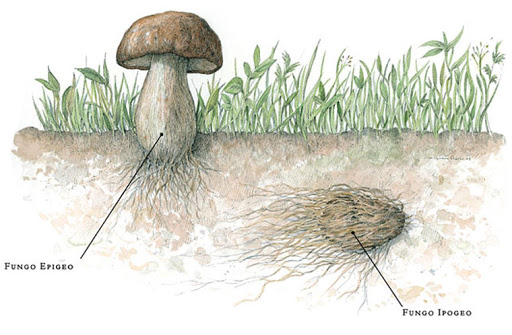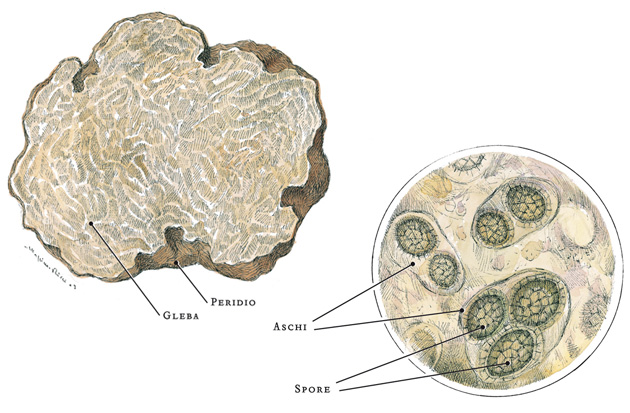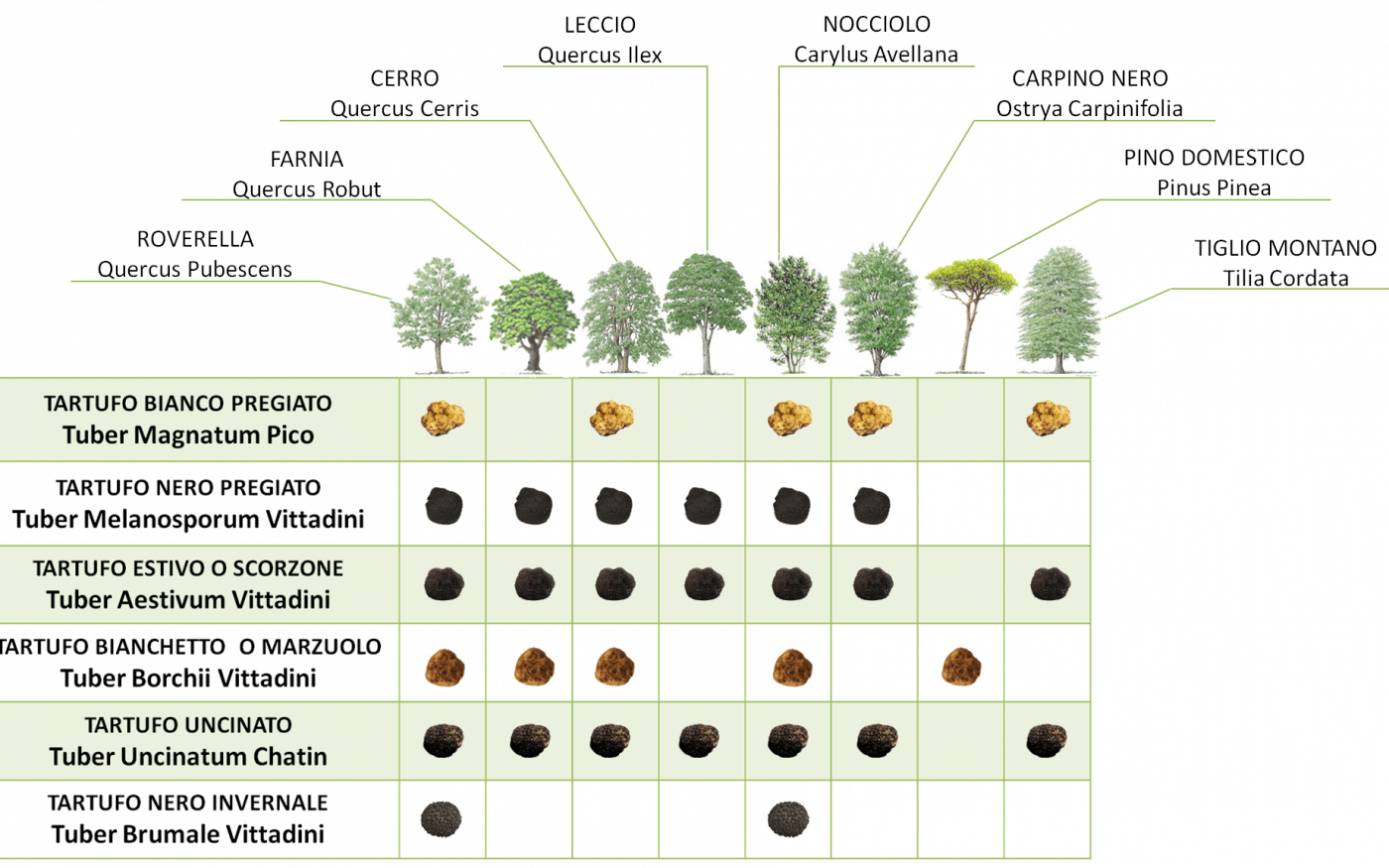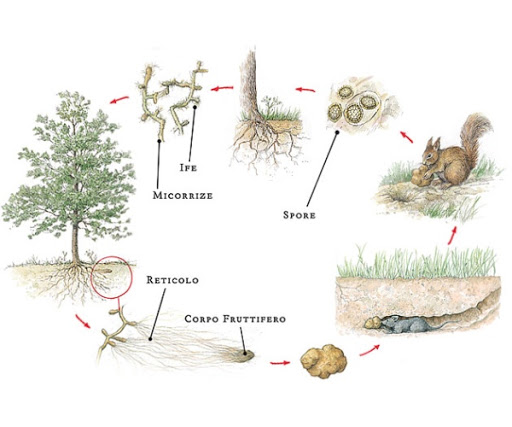What's truffle?
Truffle
Botanical origins, reproduction and physical characteristics

Botanically, truffles are particular mushrooms belonging to the genus Tuber, division Ascomycota, order Pezizales, family Tuberaceae.
Fungi or mycetes are organisms characterized by the lack of differentiated tissues (such as protozoa), by reproduction through spores and – being completely devoid of chlorophyll – by the inability to feed by synthesizing inorganic molecules.
They are divided into two categories: saprophytes, which attack and degrade non-living substances of animal or vegetable origin, and mutualistic or symbiotic fungi, which live at the expense of other species, but reciprocate their hospitality by yielding in turn useful substances.
Species of the genus Tuber are fungi that, symbiotically associated with arboreal plants, complete the entire life cycle underground.
Structure
Truffle is the common name used to indicate the fruiting body of the various species, botanically classified as sporocarp or carpophore.
Originated from the mycelium, the vegetative part of the fungus, consisting of filamentous cells called hyphae, the fruit is a mostly globular mass formed by an external part (rind or peridium), smooth or, more frequently, wrinkled or sculpted, and by a internal mass (pulp or gleba) crossed by veins, in which pouch-like structures (ascus) are immersed, containing the spores (reproductive cells).

Reproduction
Not being able to spread the spores, as surface mushrooms do, truffles give off a strong aroma: in this way the animals that are attracted to them (pigs, wild boars, squirrels, foxes, mice, snails, moles, earthworms …) feed on them, spreading the spores in the ground, to start a new cycle of reproduction.
The truffle usually forms half a meter below the surface and if it is not eaten by wild animals or quarried by man, it releases its spores when it reaches maturity to start a new life cycle.
Recognize the differences
The analysis of the characteristics of the peridium, gleba, ascus and spores, combined with the visual and organoleptic examination, allows the identification of the truffle species.
The color (which varies depending on various factors, particularly the type of superior plant to which the Tuber species is associated) and the smooth or rough appearance of the peridium, together with the seasonality of the fungus, should be sufficient to allow a consumer properly informed not to be scammed.
However, it should be borne in mind that the only way to determine with absolute certainty the species to which a truffle belongs is laboratory analysis, through the recognition of the spores or the biomolecular diagnosis of the genome.
Where does it grow
The places and symbiotic plants that lend themselves to welcoming truffles
The environment in which the truffle finds its optimal conditions is determined by an extremely delicate mix of soil type, degree of humidity, sun exposure, type of forest cover, slope of the land, altitude and other unknown phenomena that makes it unpredictable, mysterious and wild.
The soil
The type of soil is fundamental, bearing in mind that its composition is determined by the presence of various elements such as clay, sand, limestone and humus; depending on the prevalence of one of these elements, the soil can be defined as sandy, calcareous or humiferous.
The soils mainly suitable for the production of truffles are calcareous, with a degree of acidity between 6.8 and 8 ph. The White Truffle of Alba, for example, prefers a marble-calcareous soil, with a degree of acidity ranging from slightly acidic to neutral.
The climate and altitude
The atmospheric conditions have a great influence on the production of truffles, which is favored above all by the spring and summer rains.
A prolonged drought during the summer, on the other hand, can severely compromise the production of autumn and winter truffles.
This particular mushroom grows mainly in the plains, up to an altitude of 500-600 meters. There are species of truffles, however, which are able to reproduce up to 1200 meters of altitude.

The vegetation
Symbiotic plants are, as mentioned before, those that create a symbiotic relationship with the truffle, allowing it to release spores and trigger the reproduction process.
The most important, or those that enter into symbiosis with the most prized truffle, are the oaks, lime trees, poplars, willows, hornbeam and hazelnut. Those that produce black truffles differ according to the different species.
Under the foliage of these plants, areas almost totally devoid of vegetation are formed, called “pianelli”; this seems to be determined by the fact that the mycelium produces chemicals that inhibit vegetation… ingenious!
In the areas of “truffle trees” there are other species of plants called “comari”, which do not directly produce the truffle, but help to create the right conditions for the development cycle.
Ultimately, we can say that the truffle is a decidedly mysterious mushroom, a mushroom that insists on not being cultivated, that indeed is born wherever it pleases: finding it is a fortune brought by the prospector’s great ability to evaluate the environment.

The life cycle
How is the precious mushroom born and how does it reproduce?
Being an underground fungus, the truffle cannot spread the spores freely.
To reproduce, therefore, he is forced to find an alternative method: emanating a strong odor, it attracts some types of animals (such as foxes, wild boars, squirrels, foxes, moles, mice, snails, earthworms…) which feed on it and spread the spores in the ground, thus starting a new cycle of reproduction.
Subsequently the spores, germinating, give rise to a new mycelium, consisting of thin filaments called hyphae.
These filaments, in contact with the apexes of the roots of some types of symbiont plants, develop particular organs (mycorrhizae), through which the exchange of vital substances (symbiosis) is established: the plant offers carbon hydrates (sugars) and mainly receives water and mineral salts.
They are the mycorrhizae that every year, upon the occurrence of specific climatic and environmental conditions, stimulate the formation of the fruiting body, that is the real truffle.
This is formed in the soil between 30 cm and 60 cm deep, and can have a weight ranging from a few grams up to over 1 kg.
When it reaches maturity, but is not quarried, it rots and scatters its spores into the soil creating a new cycle.
